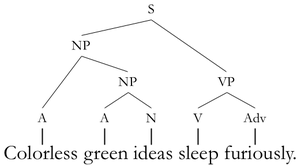
| Part of a series on |
| Linguistics |
|---|
|
|
Generative grammar is a research tradition in linguistics that aims to explain the cognitive basis of language by formulating and testing explicit models of humans' subconscious grammatical knowledge. Generative linguists, or generativists (/ˈdʒɛnərətɪvɪsts/),[1] tend to share certain working assumptions such as the competence–performance distinction and the notion that some domain-specific aspects of grammar are partly innate in humans. These assumptions are rejected in non-generative approaches such as usage-based models of language. Generative linguistics includes work in core areas such as syntax, semantics, phonology, psycholinguistics, and language acquisition, with additional extensions to topics including biolinguistics and music cognition.
Generative grammar began in the late 1950s with the work of Noam Chomsky, having roots in earlier approaches such as structural linguistics. The earliest version of Chomsky's model was called Transformational grammar, with subsequent iterations known as Government and binding theory and the Minimalist program. Other present-day generative models include Optimality theory, Categorial grammar, and Tree-adjoining grammar.
- ^ "Generativist". Dictionary.com Unabridged (Online). August 2024.